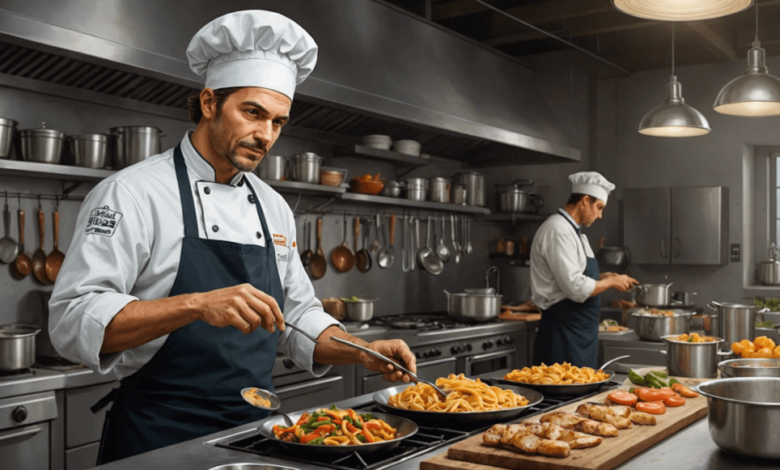Central Production Kitchen: The Backbone of Scalable Food & Beverage Operations

In the fast-evolving landscape of the food and beverage industry, scalability, efficiency, and consistency are more crucial than ever. As consumer expectations grow and food delivery becomes increasingly popular, businesses are finding innovative ways to streamline operations while maintaining high standards. One such solution that is rapidly gaining momentum is the central production kitchen model.
A central production kitchen (CPK) is a large, centralized facility designed for the preparation and processing of food items for multiple outlets or distribution points. Whether for restaurant chains, catering companies, or food delivery services, CPKs offer a powerful infrastructure that enables high-volume food production with strict quality control.
What is a Central Production Kitchen?
A central production kitchen is a centralized facility where large quantities of food are prepared, cooked, and packaged before being dispatched to various retail outlets, restaurants, or customers. Unlike individual kitchen units attached to single restaurants, a CPK serves as the central hub for multiple branches or foodservice platforms.
This model allows food brands to produce core menu items in bulk, often under stricter hygiene standards and with advanced kitchen technology, before sending them to satellite kitchens or for direct delivery.
See also: Top 11 Google Pixel 7A Back Covers That Protect Your Phone in Style
Why Central Production Kitchens are Gaining Popularity
The growth of CPKs is not accidental. Several market factors are fueling their rise:
1. Rapid Expansion of Multi-Location Food Brands
Chains and franchises aiming to maintain consistency across branches find CPKs extremely valuable. With a central hub, standardized recipes and controlled ingredients ensure that customers get the same taste and quality in every location.
2. Demand for Food Delivery
The surge in online food delivery has made centralized cooking more viable and necessary. Preparing meals in one facility and distributing them efficiently through delivery partners helps cut costs and optimize logistics.
Key Benefits of a Central Production Kitchen
1. Standardization and Quality Control
One of the most important benefits of a central production kitchen is maintaining product consistency. Every portion of sauce, dough, meat, or dressing is made using the same equipment and ingredients under uniform cooking conditions. This not only ensures taste consistency but also enhances food safety.
2. Economies of Scale
Bulk purchasing of raw materials significantly reduces the cost per unit. A central kitchen can negotiate better prices for ingredients and supplies, helping businesses increase profit margins without compromising on quality.
3. Reduced Labor Costs at Outlets
Retail locations or restaurant branches can function with fewer kitchen staff since much of the cooking is already done at the central production facility. Outlets are mainly responsible for finishing touches and plating, which reduces labor intensity and training requirements.
4. Inventory and Waste Management
With a single procurement and storage point, inventory is easier to monitor and manage. Spoilage, over-purchasing, and wastage can be minimized using centralized tracking systems and portion control.
Who Can Benefit from Central Production Kitchens?
A central production kitchen is not only for large-scale fast-food giants. The model is adaptable and beneficial to a wide range of businesses in the food and beverage space:
- Restaurant chains and franchises
- Catering companies
- Meal kit providers
- Institutional food service providers (schools, hospitals, airlines)
- Dark kitchens/Cloud kitchens with multiple brands
Whether serving 10 or 100 locations, a CPK can streamline operations and enable smoother scaling.
Setting Up a Central Production Kitchen: What to Consider
Launching a central production kitchen requires strategic planning. Here are key considerations for setup:
1. Location Selection
Proximity to your outlets or delivery zones is essential. The closer the CPK is to the points of sale, the fresher the product will be on arrival and the lower your transportation costs.
2. Facility Design and Workflow
The layout should ensure smooth flow—from raw material intake to cooking, packing, and dispatch. It should comply with food safety regulations and accommodate necessary equipment, cold storage, and hygiene zones.
3. Staffing and Training
A skilled team including chefs, production managers, and food safety officers is necessary. Staff must be trained not only in food preparation but also in sanitation, packaging, and handling logistics.
4. Equipment Investment
Depending on the food being produced, equipment can include commercial ovens, blast chillers, vacuum packers, dough mixers, automated cooking lines, and portioning machines. Proper planning ensures equipment matches the scale and complexity of operations.
5. Technology Integration
Modern CPKs are powered by tech solutions—inventory management software, order tracking systems, quality control tools, and real-time dashboards for productivity monitoring. These tools enhance accuracy and accountability.
Challenges in Operating a Central Production Kitchen
While CPKs offer efficiency and scalability, they are not without challenges:
– Initial Capital Investment
Building a CPK requires significant upfront investment in space, equipment, staffing, and compliance. However, these costs are often offset by long-term savings and operational gains.
– Logistics and Delivery
Timely distribution of food to different outlets is critical. Delays can lead to spoilage or dissatisfaction. Partnering with reliable logistics providers or developing in-house transport solutions is vital.
– Product Freshness
Ensuring that food prepared in bulk retains its flavor and texture during storage and delivery is a concern. Techniques like vacuum sealing, blast chilling, and sous vide cooking can help maintain freshness.
Conclusion
A central production kitchen is much more than a food preparation space—it’s the operational engine behind successful, scalable food enterprises. By centralizing cooking, reducing waste, and ensuring uniform quality, businesses can meet growing consumer demands while maintaining operational efficiency.
As the food and beverage landscape becomes more competitive, investing in a central production kitchen model may be the strategic advantage that sets brands apart. Whether you’re a catering business, restaurant chain, or an ambitious startup, the future of food production might just begin in a centralized, high-performance kitchen.




